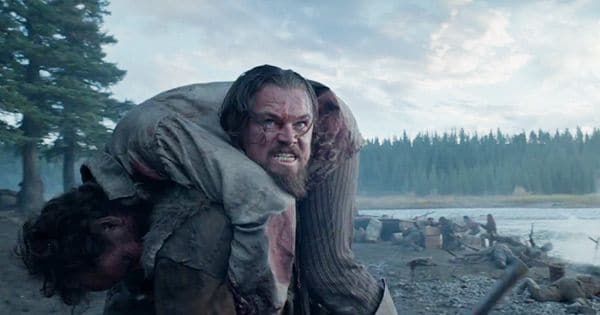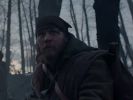Eye For Film >> Movies >> The Revenant (2015) Film Review
The Revenant
Reviewed by: Amber Wilkinson

If there is one thing that cinema has tried to teach us lately it is that the American wilderness is unforgiving, no matter whether the journey is played for comedy (A Walk In The Woods) or drama (Into The Wild, Wild). Alejandro González Iñárritu makes sure this point is hammered home by setting the action of The Revenant against the brutal backdrop of bleak mid-winter somewhere on the frontier along the banks of the (wild) Missouri and letting the Emmanuel Lubezki's camera take a long, hard look.
Times are tough, women are either chattels or the stuff of magical realist dream sequences and dialogue is frequently cut adrift in favour of animalistic grunts and muscularity. Nothing, Iñárritu implies, is funny about this, and woe betide you if he catches any of the audience snickering at the sight of Tom Hardy with a dead otter perched on his head.

At the heart of the action stands Leonardo DiCaprio as Hugh Glass - even the name suggests cold splintering - and the 'revenant' of the title. He is a tracker for the local fur company, helping trappers to navigate the grim backwaters, while avoiding being scalped by the local Arikara tribe, referred to throughout the film as "the Ree". With him is his son Hawk (Forrest Goodluck), the only thing he has left from his marriage to a Pawnee woman, glimpsed in tragic flashbacks that marry crushing violence to the sort of 'wind playing through hair' sequences beloved of conditioner advertisers.
All the character archetypes are assembled - the noble Captain (Domhnall Gleeson, playing Andrew Henry), the wet-behind-the-years youngster (Will Poulter, who really is going from strength to strength in Hollywood, as Jim Bridger) and the bad guy with a vicious streak a mile wide (Tom Hardy as John Fitzgerald). Their set up is the model of economy and intensity as we see them plunged into a skirmish with the Ree, the whistle and thud of arrows mingling with the splash of mud and scent of fear. As the last men standing attempt to make it back to their distant fort, Glass finds himself in a face-off with a bear - a gripping and visceral encounter that feels crushingly, maulingly, slashingly real. This sets the scene for the rest of the film that will see Glass go in pursuit of vengeance against Fitzgerald, no matter what the cost.
In terms of craft, this film is gold. The long takes give verve to the action sequences and Lubezki's frequent decision to keep his camera low, so that the trees and nature seem to loom and crowd in on the rag-tag humans emphasises the loneliness. The soundscape too feels blood-lettingly real and is gracefully supported by the scoring from Ryuichi Sakamoto, Alva Noto and Bryce Dessner - the best I can recall this year - which insinuates its way into the action rather than announcing itself and never upstages what is going on (Room composer Stephen Rennicks should take some notes). The CGI work on the bear, meanwhile, is the business, although there's a suspicion that all the money was spent here when a later scene involving wolves and bison looks off-puttingly fake.
Despite this - and sometimes paradoxically because of this - the film has problems. Reality, in general, suggests mess - take a look around you right now and, unless you are living in a despotic regime or have recently tidied your house to within an inch of its life you'll see plenty of things that look muddled. Yet, in The Revenant, there is never so much as a twig or a smear of mud out of place. It looks beautiful, certainly, but not real. This unreality - occasionally emphasised by sequences in which breath steams up the camera lens or water splashes it - is at odds with the gritty story, which positively calls for things to be unkempt.
Emotionally, Iñárritu and Mark L Smith also refuse to get their hands dirty. They outline the bond between Glass and Hawk without exploring it so that the vengeance and violence lacks a vital counterpoint. The Native Americans, meanwhile, never move beyond the "noble savage" stereotype, although in fairness, the suggestion is that the landscape drives everyone savagery in the end.
DiCaprio - who was hotly tipped to finally get his Oscar even before the film was released - gives it his all physically, hauling himself across ice, dragging himself from rivers and conveying Glass' pain mostly through grunts. But for all his commitment, the script fails to sufficiently back up his anguish, so that it is the memory of the stand-offs between Hardy's fearless Fitzgerald and Gleeson's by-the-book captain that linger best in the memory.
Perhaps most damning of all, though, is that despite being chilly, the action also becomes a bit silly when you think about it. Glass displays almost Terminator-like skills of rejuvenation and Iñárritu's refusal to allow any humour means that it leaks out, unfortunately, in the wrong places (Domhnall Gleeson's Russian cossack-style hat - yes, another one - generated giggles at the screening I attended). Beautiful and brutal it may be but it is the film's lack of depth that ultimately leaves you cold.
Reviewed on: 15 Dec 2015
















